Financial Decision Making
VerifiedAdded on 2023/01/09
|11
|3571
|97
AI Summary
This article discusses the importance of financial decision making in the growth of a corporation and the functions and duties of accounting and finance departments. It also includes the computation of key ratios to evaluate the company's performance. The subject is Financial Decision Making and the document type is an article.
Contribute Materials
Your contribution can guide someone’s learning journey. Share your
documents today.

Financial Decision Making
Secure Best Marks with AI Grader
Need help grading? Try our AI Grader for instant feedback on your assignments.
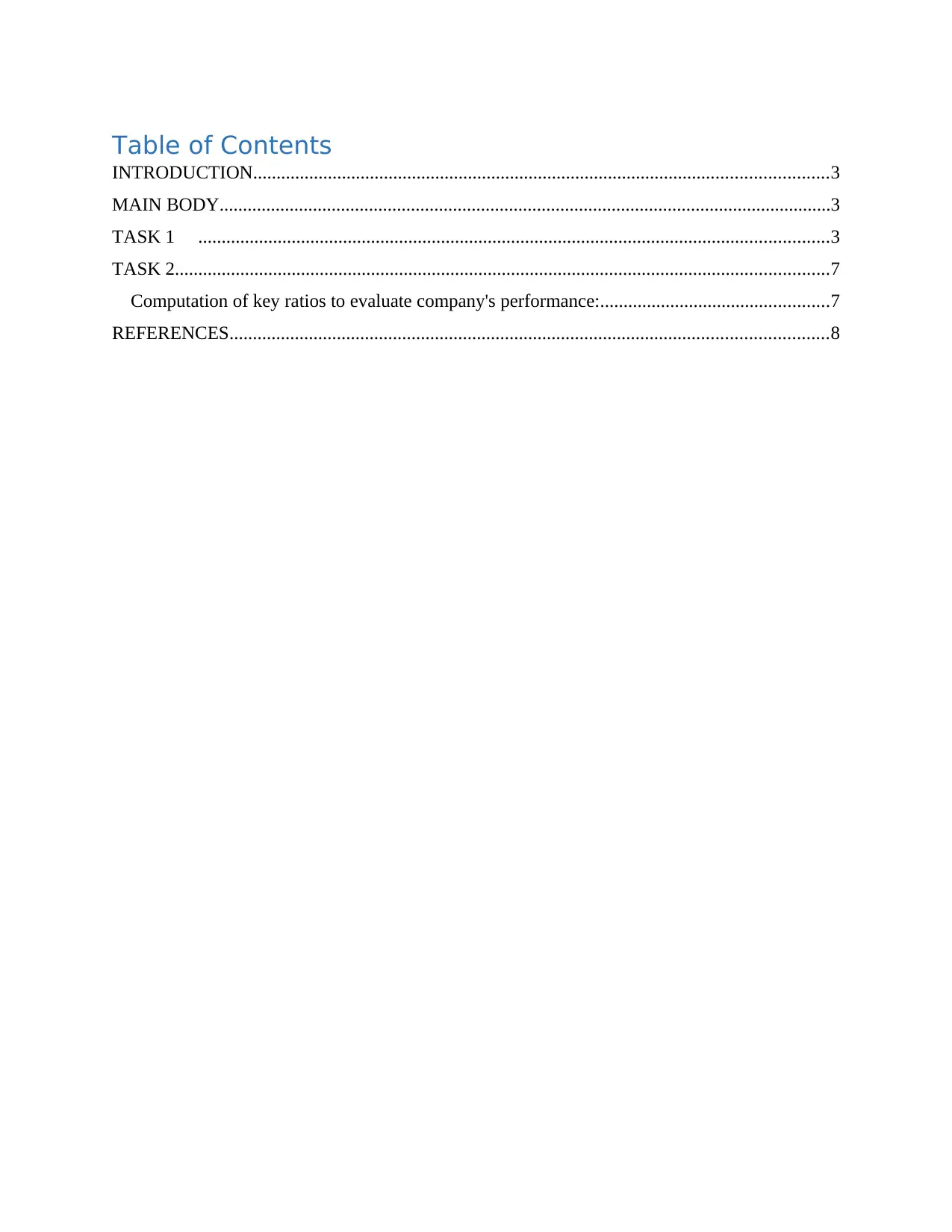
Table of Contents
INTRODUCTION...........................................................................................................................3
MAIN BODY...................................................................................................................................3
TASK 1 .......................................................................................................................................3
TASK 2............................................................................................................................................7
Computation of key ratios to evaluate company's performance:.................................................7
REFERENCES................................................................................................................................8
INTRODUCTION...........................................................................................................................3
MAIN BODY...................................................................................................................................3
TASK 1 .......................................................................................................................................3
TASK 2............................................................................................................................................7
Computation of key ratios to evaluate company's performance:.................................................7
REFERENCES................................................................................................................................8
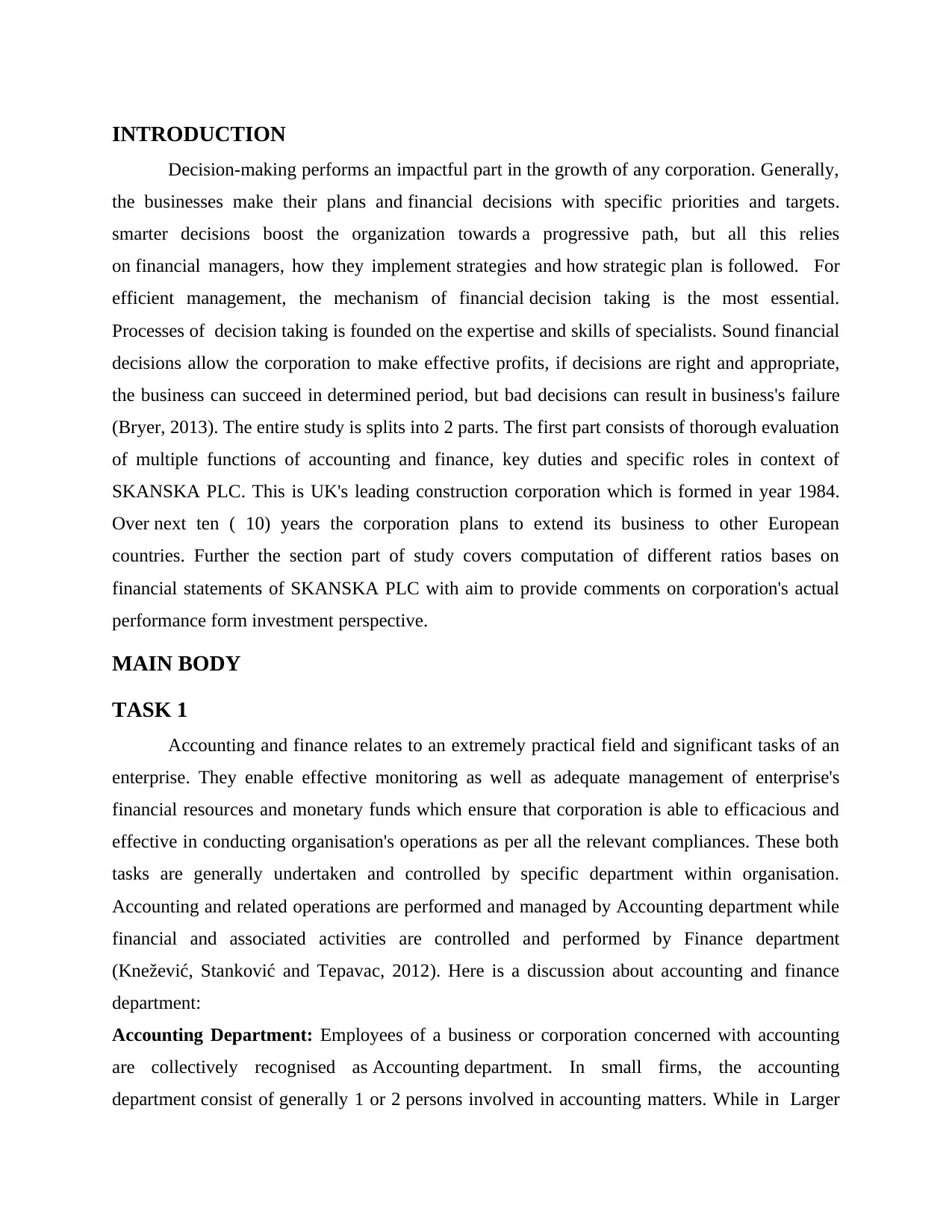
INTRODUCTION
Decision-making performs an impactful part in the growth of any corporation. Generally,
the businesses make their plans and financial decisions with specific priorities and targets.
smarter decisions boost the organization towards a progressive path, but all this relies
on financial managers, how they implement strategies and how strategic plan is followed. For
efficient management, the mechanism of financial decision taking is the most essential.
Processes of decision taking is founded on the expertise and skills of specialists. Sound financial
decisions allow the corporation to make effective profits, if decisions are right and appropriate,
the business can succeed in determined period, but bad decisions can result in business's failure
(Bryer, 2013). The entire study is splits into 2 parts. The first part consists of thorough evaluation
of multiple functions of accounting and finance, key duties and specific roles in context of
SKANSKA PLC. This is UK's leading construction corporation which is formed in year 1984.
Over next ten ( 10) years the corporation plans to extend its business to other European
countries. Further the section part of study covers computation of different ratios bases on
financial statements of SKANSKA PLC with aim to provide comments on corporation's actual
performance form investment perspective.
MAIN BODY
TASK 1
Accounting and finance relates to an extremely practical field and significant tasks of an
enterprise. They enable effective monitoring as well as adequate management of enterprise's
financial resources and monetary funds which ensure that corporation is able to efficacious and
effective in conducting organisation's operations as per all the relevant compliances. These both
tasks are generally undertaken and controlled by specific department within organisation.
Accounting and related operations are performed and managed by Accounting department while
financial and associated activities are controlled and performed by Finance department
(Knežević, Stanković and Tepavac, 2012). Here is a discussion about accounting and finance
department:
Accounting Department: Employees of a business or corporation concerned with accounting
are collectively recognised as Accounting department. In small firms, the accounting
department consist of generally 1 or 2 persons involved in accounting matters. While in Larger
Decision-making performs an impactful part in the growth of any corporation. Generally,
the businesses make their plans and financial decisions with specific priorities and targets.
smarter decisions boost the organization towards a progressive path, but all this relies
on financial managers, how they implement strategies and how strategic plan is followed. For
efficient management, the mechanism of financial decision taking is the most essential.
Processes of decision taking is founded on the expertise and skills of specialists. Sound financial
decisions allow the corporation to make effective profits, if decisions are right and appropriate,
the business can succeed in determined period, but bad decisions can result in business's failure
(Bryer, 2013). The entire study is splits into 2 parts. The first part consists of thorough evaluation
of multiple functions of accounting and finance, key duties and specific roles in context of
SKANSKA PLC. This is UK's leading construction corporation which is formed in year 1984.
Over next ten ( 10) years the corporation plans to extend its business to other European
countries. Further the section part of study covers computation of different ratios bases on
financial statements of SKANSKA PLC with aim to provide comments on corporation's actual
performance form investment perspective.
MAIN BODY
TASK 1
Accounting and finance relates to an extremely practical field and significant tasks of an
enterprise. They enable effective monitoring as well as adequate management of enterprise's
financial resources and monetary funds which ensure that corporation is able to efficacious and
effective in conducting organisation's operations as per all the relevant compliances. These both
tasks are generally undertaken and controlled by specific department within organisation.
Accounting and related operations are performed and managed by Accounting department while
financial and associated activities are controlled and performed by Finance department
(Knežević, Stanković and Tepavac, 2012). Here is a discussion about accounting and finance
department:
Accounting Department: Employees of a business or corporation concerned with accounting
are collectively recognised as Accounting department. In small firms, the accounting
department consist of generally 1 or 2 persons involved in accounting matters. While in Larger
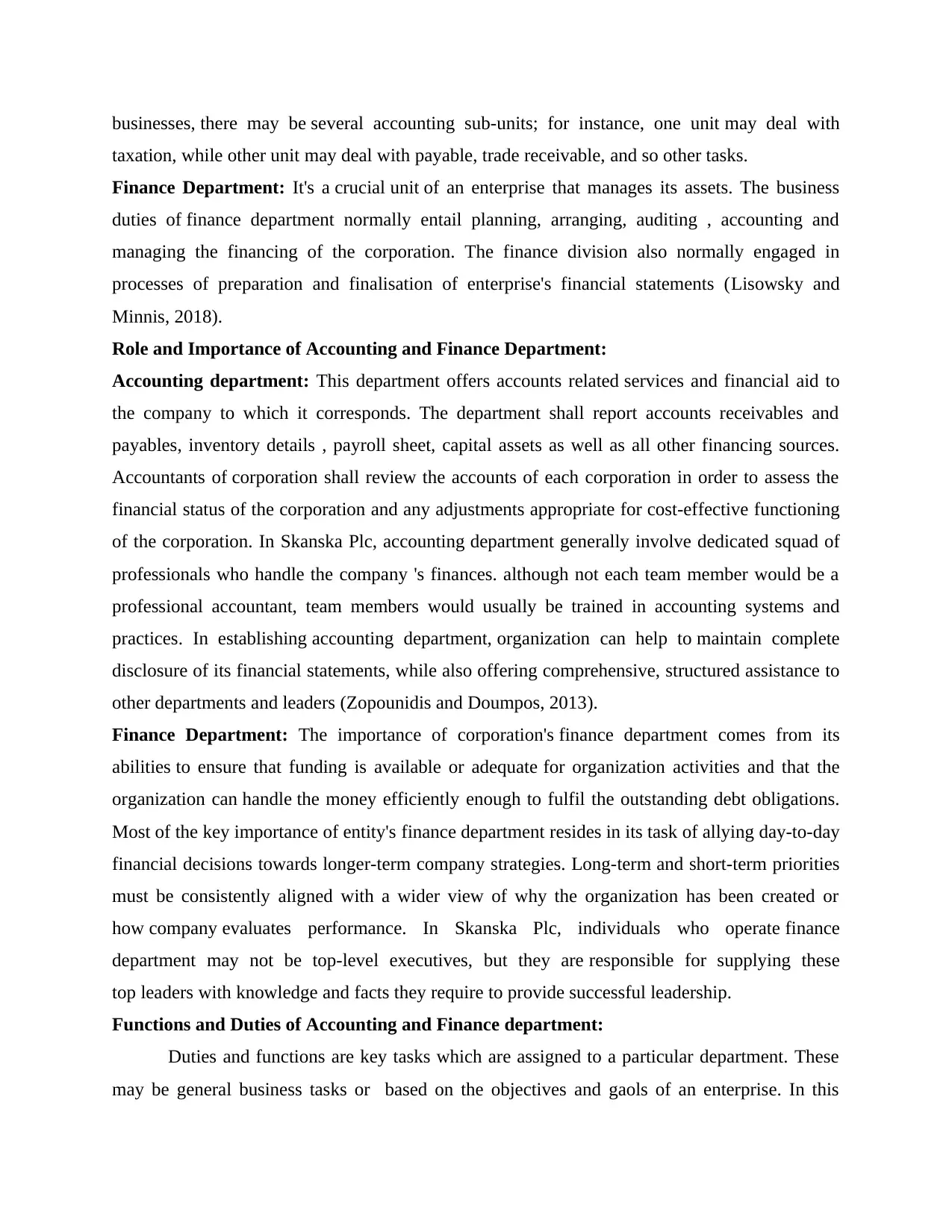
businesses, there may be several accounting sub-units; for instance, one unit may deal with
taxation, while other unit may deal with payable, trade receivable, and so other tasks.
Finance Department: It's a crucial unit of an enterprise that manages its assets. The business
duties of finance department normally entail planning, arranging, auditing , accounting and
managing the financing of the corporation. The finance division also normally engaged in
processes of preparation and finalisation of enterprise's financial statements (Lisowsky and
Minnis, 2018).
Role and Importance of Accounting and Finance Department:
Accounting department: This department offers accounts related services and financial aid to
the company to which it corresponds. The department shall report accounts receivables and
payables, inventory details , payroll sheet, capital assets as well as all other financing sources.
Accountants of corporation shall review the accounts of each corporation in order to assess the
financial status of the corporation and any adjustments appropriate for cost-effective functioning
of the corporation. In Skanska Plc, accounting department generally involve dedicated squad of
professionals who handle the company 's finances. although not each team member would be a
professional accountant, team members would usually be trained in accounting systems and
practices. In establishing accounting department, organization can help to maintain complete
disclosure of its financial statements, while also offering comprehensive, structured assistance to
other departments and leaders (Zopounidis and Doumpos, 2013).
Finance Department: The importance of corporation's finance department comes from its
abilities to ensure that funding is available or adequate for organization activities and that the
organization can handle the money efficiently enough to fulfil the outstanding debt obligations.
Most of the key importance of entity's finance department resides in its task of allying day-to-day
financial decisions towards longer-term company strategies. Long-term and short-term priorities
must be consistently aligned with a wider view of why the organization has been created or
how company evaluates performance. In Skanska Plc, individuals who operate finance
department may not be top-level executives, but they are responsible for supplying these
top leaders with knowledge and facts they require to provide successful leadership.
Functions and Duties of Accounting and Finance department:
Duties and functions are key tasks which are assigned to a particular department. These
may be general business tasks or based on the objectives and gaols of an enterprise. In this
taxation, while other unit may deal with payable, trade receivable, and so other tasks.
Finance Department: It's a crucial unit of an enterprise that manages its assets. The business
duties of finance department normally entail planning, arranging, auditing , accounting and
managing the financing of the corporation. The finance division also normally engaged in
processes of preparation and finalisation of enterprise's financial statements (Lisowsky and
Minnis, 2018).
Role and Importance of Accounting and Finance Department:
Accounting department: This department offers accounts related services and financial aid to
the company to which it corresponds. The department shall report accounts receivables and
payables, inventory details , payroll sheet, capital assets as well as all other financing sources.
Accountants of corporation shall review the accounts of each corporation in order to assess the
financial status of the corporation and any adjustments appropriate for cost-effective functioning
of the corporation. In Skanska Plc, accounting department generally involve dedicated squad of
professionals who handle the company 's finances. although not each team member would be a
professional accountant, team members would usually be trained in accounting systems and
practices. In establishing accounting department, organization can help to maintain complete
disclosure of its financial statements, while also offering comprehensive, structured assistance to
other departments and leaders (Zopounidis and Doumpos, 2013).
Finance Department: The importance of corporation's finance department comes from its
abilities to ensure that funding is available or adequate for organization activities and that the
organization can handle the money efficiently enough to fulfil the outstanding debt obligations.
Most of the key importance of entity's finance department resides in its task of allying day-to-day
financial decisions towards longer-term company strategies. Long-term and short-term priorities
must be consistently aligned with a wider view of why the organization has been created or
how company evaluates performance. In Skanska Plc, individuals who operate finance
department may not be top-level executives, but they are responsible for supplying these
top leaders with knowledge and facts they require to provide successful leadership.
Functions and Duties of Accounting and Finance department:
Duties and functions are key tasks which are assigned to a particular department. These
may be general business tasks or based on the objectives and gaols of an enterprise. In this
Secure Best Marks with AI Grader
Need help grading? Try our AI Grader for instant feedback on your assignments.
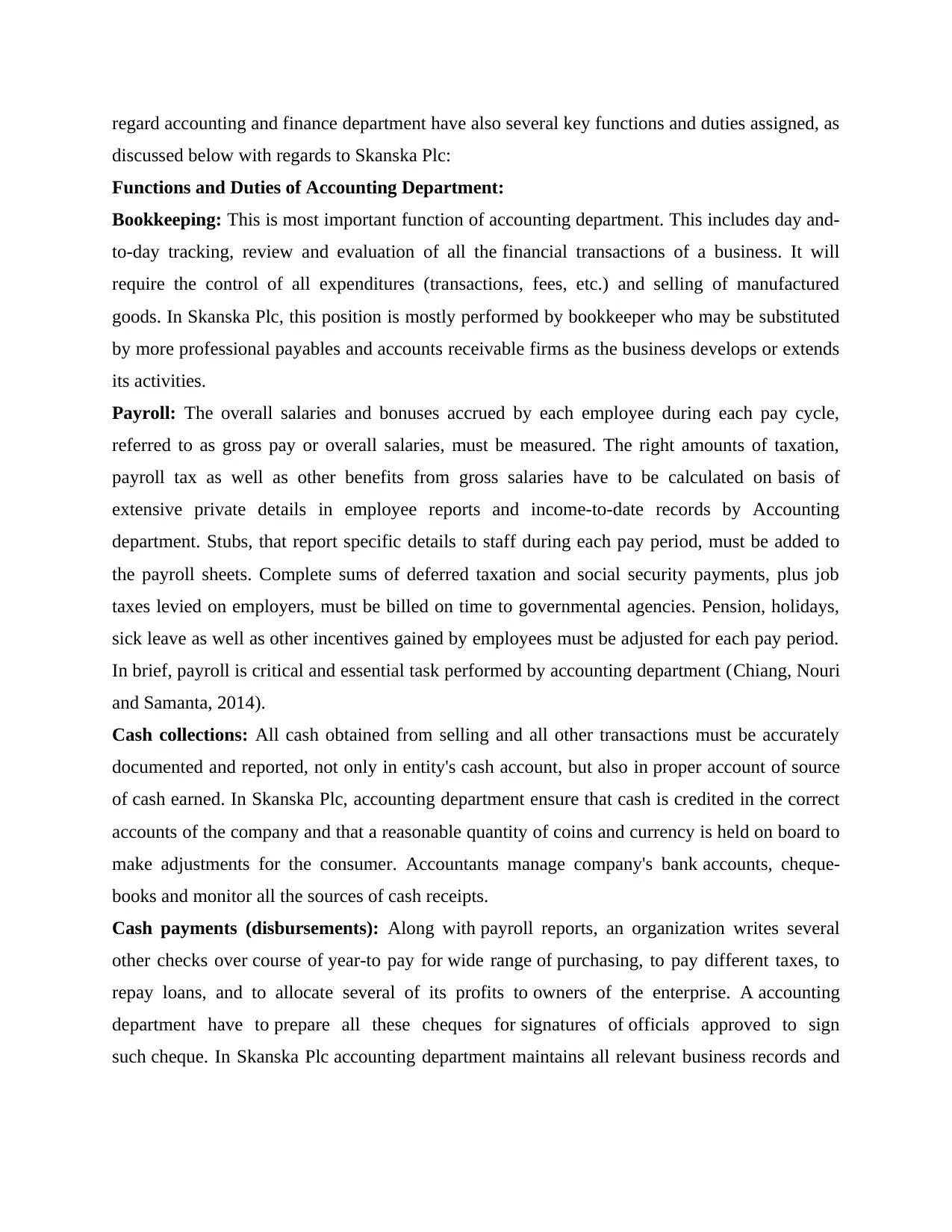
regard accounting and finance department have also several key functions and duties assigned, as
discussed below with regards to Skanska Plc:
Functions and Duties of Accounting Department:
Bookkeeping: This is most important function of accounting department. This includes day and-
to-day tracking, review and evaluation of all the financial transactions of a business. It will
require the control of all expenditures (transactions, fees, etc.) and selling of manufactured
goods. In Skanska Plc, this position is mostly performed by bookkeeper who may be substituted
by more professional payables and accounts receivable firms as the business develops or extends
its activities.
Payroll: The overall salaries and bonuses accrued by each employee during each pay cycle,
referred to as gross pay or overall salaries, must be measured. The right amounts of taxation,
payroll tax as well as other benefits from gross salaries have to be calculated on basis of
extensive private details in employee reports and income-to-date records by Accounting
department. Stubs, that report specific details to staff during each pay period, must be added to
the payroll sheets. Complete sums of deferred taxation and social security payments, plus job
taxes levied on employers, must be billed on time to governmental agencies. Pension, holidays,
sick leave as well as other incentives gained by employees must be adjusted for each pay period.
In brief, payroll is critical and essential task performed by accounting department (Chiang, Nouri
and Samanta, 2014).
Cash collections: All cash obtained from selling and all other transactions must be accurately
documented and reported, not only in entity's cash account, but also in proper account of source
of cash earned. In Skanska Plc, accounting department ensure that cash is credited in the correct
accounts of the company and that a reasonable quantity of coins and currency is held on board to
make adjustments for the consumer. Accountants manage company's bank accounts, cheque-
books and monitor all the sources of cash receipts.
Cash payments (disbursements): Along with payroll reports, an organization writes several
other checks over course of year-to pay for wide range of purchasing, to pay different taxes, to
repay loans, and to allocate several of its profits to owners of the enterprise. A accounting
department have to prepare all these cheques for signatures of officials approved to sign
such cheque. In Skanska Plc accounting department maintains all relevant business records and
discussed below with regards to Skanska Plc:
Functions and Duties of Accounting Department:
Bookkeeping: This is most important function of accounting department. This includes day and-
to-day tracking, review and evaluation of all the financial transactions of a business. It will
require the control of all expenditures (transactions, fees, etc.) and selling of manufactured
goods. In Skanska Plc, this position is mostly performed by bookkeeper who may be substituted
by more professional payables and accounts receivable firms as the business develops or extends
its activities.
Payroll: The overall salaries and bonuses accrued by each employee during each pay cycle,
referred to as gross pay or overall salaries, must be measured. The right amounts of taxation,
payroll tax as well as other benefits from gross salaries have to be calculated on basis of
extensive private details in employee reports and income-to-date records by Accounting
department. Stubs, that report specific details to staff during each pay period, must be added to
the payroll sheets. Complete sums of deferred taxation and social security payments, plus job
taxes levied on employers, must be billed on time to governmental agencies. Pension, holidays,
sick leave as well as other incentives gained by employees must be adjusted for each pay period.
In brief, payroll is critical and essential task performed by accounting department (Chiang, Nouri
and Samanta, 2014).
Cash collections: All cash obtained from selling and all other transactions must be accurately
documented and reported, not only in entity's cash account, but also in proper account of source
of cash earned. In Skanska Plc, accounting department ensure that cash is credited in the correct
accounts of the company and that a reasonable quantity of coins and currency is held on board to
make adjustments for the consumer. Accountants manage company's bank accounts, cheque-
books and monitor all the sources of cash receipts.
Cash payments (disbursements): Along with payroll reports, an organization writes several
other checks over course of year-to pay for wide range of purchasing, to pay different taxes, to
repay loans, and to allocate several of its profits to owners of the enterprise. A accounting
department have to prepare all these cheques for signatures of officials approved to sign
such cheque. In Skanska Plc accounting department maintains all relevant business records and
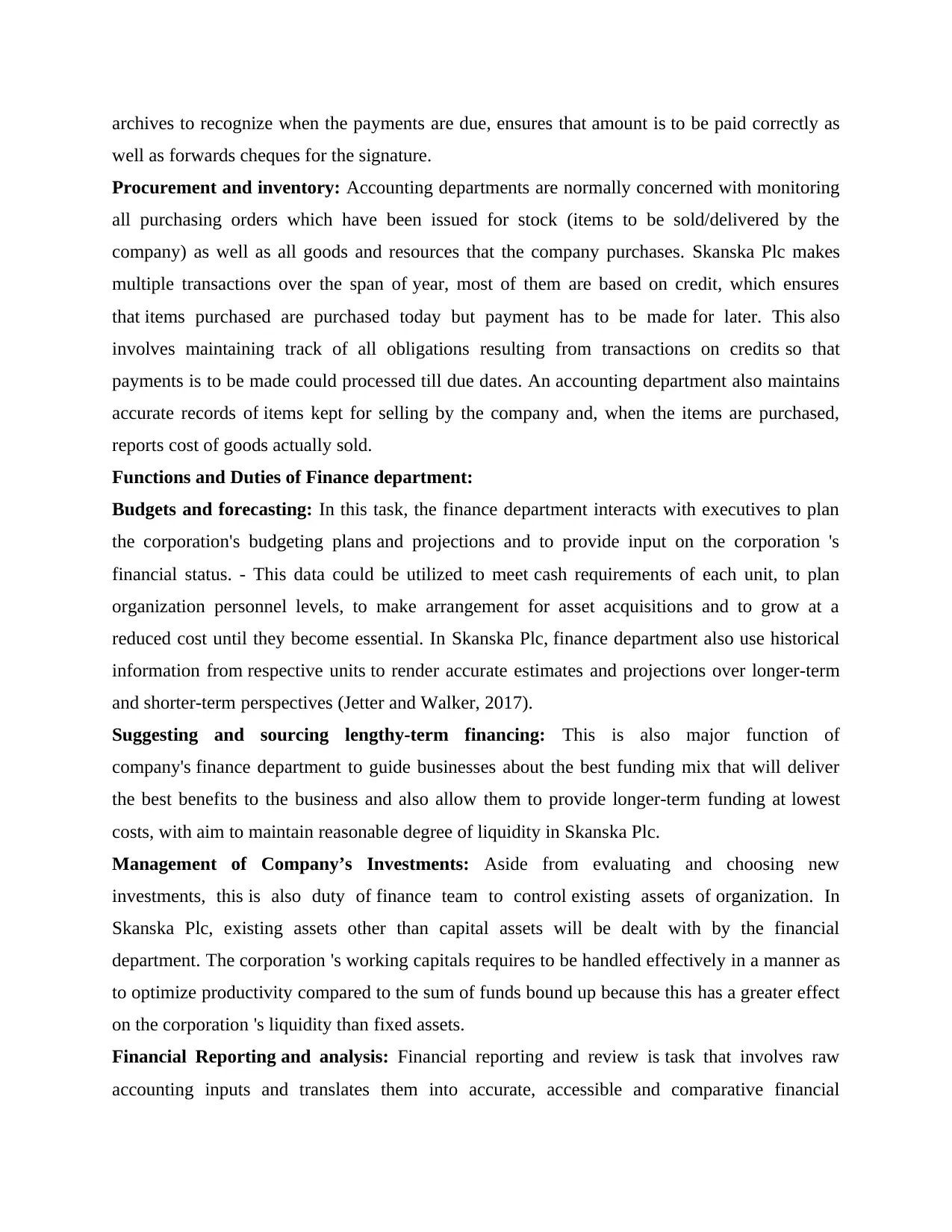
archives to recognize when the payments are due, ensures that amount is to be paid correctly as
well as forwards cheques for the signature.
Procurement and inventory: Accounting departments are normally concerned with monitoring
all purchasing orders which have been issued for stock (items to be sold/delivered by the
company) as well as all goods and resources that the company purchases. Skanska Plc makes
multiple transactions over the span of year, most of them are based on credit, which ensures
that items purchased are purchased today but payment has to be made for later. This also
involves maintaining track of all obligations resulting from transactions on credits so that
payments is to be made could processed till due dates. An accounting department also maintains
accurate records of items kept for selling by the company and, when the items are purchased,
reports cost of goods actually sold.
Functions and Duties of Finance department:
Budgets and forecasting: In this task, the finance department interacts with executives to plan
the corporation's budgeting plans and projections and to provide input on the corporation 's
financial status. - This data could be utilized to meet cash requirements of each unit, to plan
organization personnel levels, to make arrangement for asset acquisitions and to grow at a
reduced cost until they become essential. In Skanska Plc, finance department also use historical
information from respective units to render accurate estimates and projections over longer-term
and shorter-term perspectives (Jetter and Walker, 2017).
Suggesting and sourcing lengthy-term financing: This is also major function of
company's finance department to guide businesses about the best funding mix that will deliver
the best benefits to the business and also allow them to provide longer-term funding at lowest
costs, with aim to maintain reasonable degree of liquidity in Skanska Plc.
Management of Company’s Investments: Aside from evaluating and choosing new
investments, this is also duty of finance team to control existing assets of organization. In
Skanska Plc, existing assets other than capital assets will be dealt with by the financial
department. The corporation 's working capitals requires to be handled effectively in a manner as
to optimize productivity compared to the sum of funds bound up because this has a greater effect
on the corporation 's liquidity than fixed assets.
Financial Reporting and analysis: Financial reporting and review is task that involves raw
accounting inputs and translates them into accurate, accessible and comparative financial
well as forwards cheques for the signature.
Procurement and inventory: Accounting departments are normally concerned with monitoring
all purchasing orders which have been issued for stock (items to be sold/delivered by the
company) as well as all goods and resources that the company purchases. Skanska Plc makes
multiple transactions over the span of year, most of them are based on credit, which ensures
that items purchased are purchased today but payment has to be made for later. This also
involves maintaining track of all obligations resulting from transactions on credits so that
payments is to be made could processed till due dates. An accounting department also maintains
accurate records of items kept for selling by the company and, when the items are purchased,
reports cost of goods actually sold.
Functions and Duties of Finance department:
Budgets and forecasting: In this task, the finance department interacts with executives to plan
the corporation's budgeting plans and projections and to provide input on the corporation 's
financial status. - This data could be utilized to meet cash requirements of each unit, to plan
organization personnel levels, to make arrangement for asset acquisitions and to grow at a
reduced cost until they become essential. In Skanska Plc, finance department also use historical
information from respective units to render accurate estimates and projections over longer-term
and shorter-term perspectives (Jetter and Walker, 2017).
Suggesting and sourcing lengthy-term financing: This is also major function of
company's finance department to guide businesses about the best funding mix that will deliver
the best benefits to the business and also allow them to provide longer-term funding at lowest
costs, with aim to maintain reasonable degree of liquidity in Skanska Plc.
Management of Company’s Investments: Aside from evaluating and choosing new
investments, this is also duty of finance team to control existing assets of organization. In
Skanska Plc, existing assets other than capital assets will be dealt with by the financial
department. The corporation 's working capitals requires to be handled effectively in a manner as
to optimize productivity compared to the sum of funds bound up because this has a greater effect
on the corporation 's liquidity than fixed assets.
Financial Reporting and analysis: Financial reporting and review is task that involves raw
accounting inputs and translates them into accurate, accessible and comparative financial
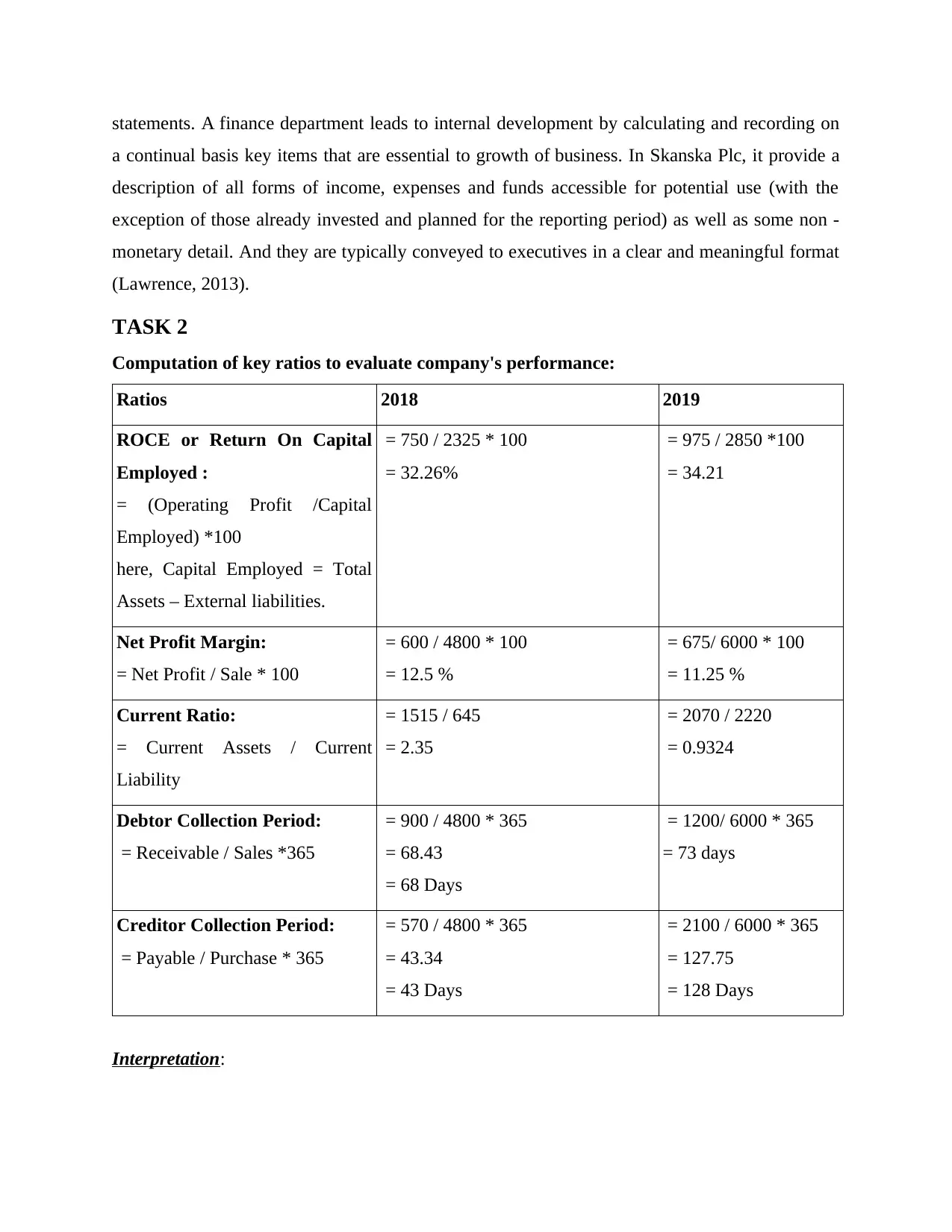
statements. A finance department leads to internal development by calculating and recording on
a continual basis key items that are essential to growth of business. In Skanska Plc, it provide a
description of all forms of income, expenses and funds accessible for potential use (with the
exception of those already invested and planned for the reporting period) as well as some non -
monetary detail. And they are typically conveyed to executives in a clear and meaningful format
(Lawrence, 2013).
TASK 2
Computation of key ratios to evaluate company's performance:
Ratios 2018 2019
ROCE or Return On Capital
Employed :
= (Operating Profit /Capital
Employed) *100
here, Capital Employed = Total
Assets – External liabilities.
= 750 / 2325 * 100
= 32.26%
= 975 / 2850 *100
= 34.21
Net Profit Margin:
= Net Profit / Sale * 100
= 600 / 4800 * 100
= 12.5 %
= 675/ 6000 * 100
= 11.25 %
Current Ratio:
= Current Assets / Current
Liability
= 1515 / 645
= 2.35
= 2070 / 2220
= 0.9324
Debtor Collection Period:
= Receivable / Sales *365
= 900 / 4800 * 365
= 68.43
= 68 Days
= 1200/ 6000 * 365
= 73 days
Creditor Collection Period:
= Payable / Purchase * 365
= 570 / 4800 * 365
= 43.34
= 43 Days
= 2100 / 6000 * 365
= 127.75
= 128 Days
Interpretation:
a continual basis key items that are essential to growth of business. In Skanska Plc, it provide a
description of all forms of income, expenses and funds accessible for potential use (with the
exception of those already invested and planned for the reporting period) as well as some non -
monetary detail. And they are typically conveyed to executives in a clear and meaningful format
(Lawrence, 2013).
TASK 2
Computation of key ratios to evaluate company's performance:
Ratios 2018 2019
ROCE or Return On Capital
Employed :
= (Operating Profit /Capital
Employed) *100
here, Capital Employed = Total
Assets – External liabilities.
= 750 / 2325 * 100
= 32.26%
= 975 / 2850 *100
= 34.21
Net Profit Margin:
= Net Profit / Sale * 100
= 600 / 4800 * 100
= 12.5 %
= 675/ 6000 * 100
= 11.25 %
Current Ratio:
= Current Assets / Current
Liability
= 1515 / 645
= 2.35
= 2070 / 2220
= 0.9324
Debtor Collection Period:
= Receivable / Sales *365
= 900 / 4800 * 365
= 68.43
= 68 Days
= 1200/ 6000 * 365
= 73 days
Creditor Collection Period:
= Payable / Purchase * 365
= 570 / 4800 * 365
= 43.34
= 43 Days
= 2100 / 6000 * 365
= 127.75
= 128 Days
Interpretation:
Paraphrase This Document
Need a fresh take? Get an instant paraphrase of this document with our AI Paraphraser
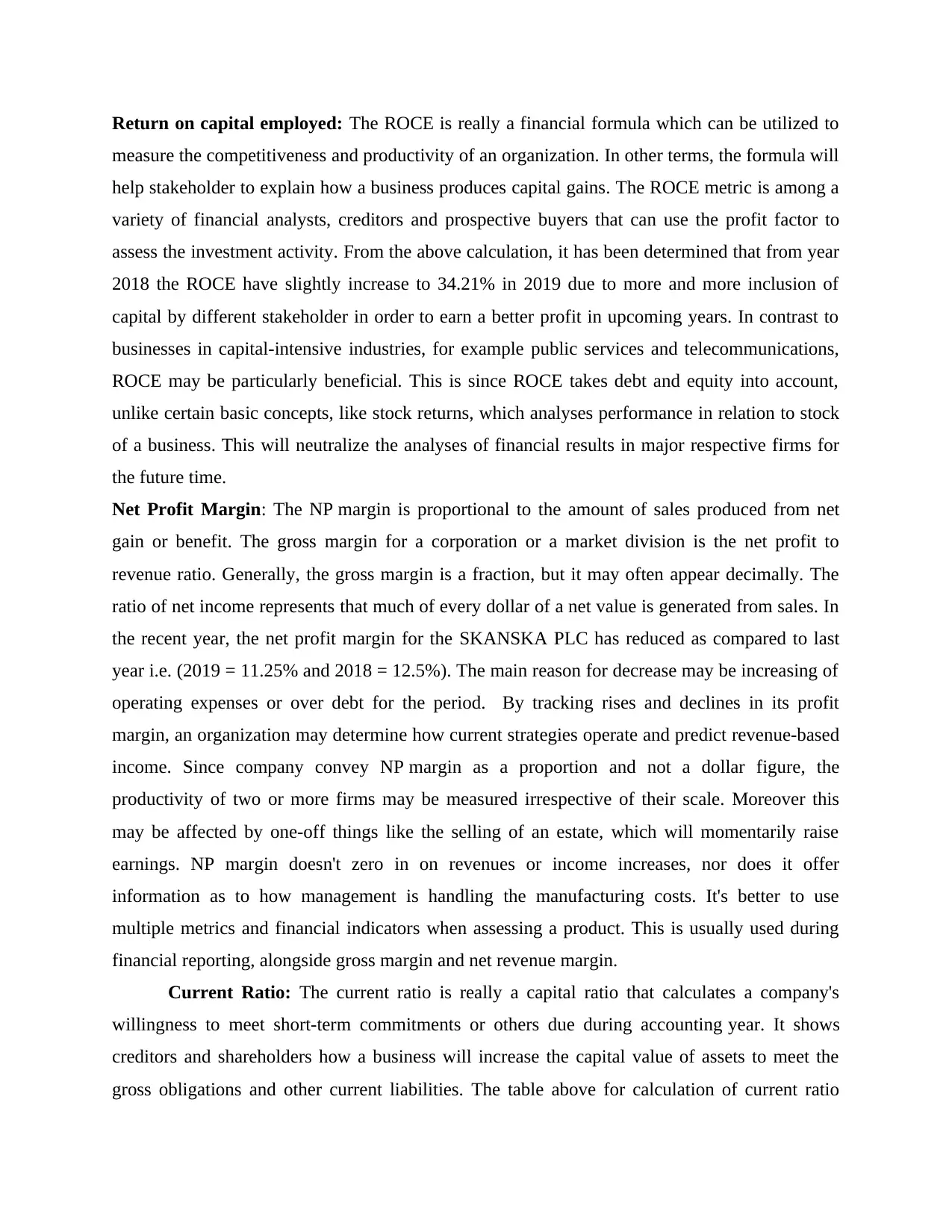
Return on capital employed: The ROCE is really a financial formula which can be utilized to
measure the competitiveness and productivity of an organization. In other terms, the formula will
help stakeholder to explain how a business produces capital gains. The ROCE metric is among a
variety of financial analysts, creditors and prospective buyers that can use the profit factor to
assess the investment activity. From the above calculation, it has been determined that from year
2018 the ROCE have slightly increase to 34.21% in 2019 due to more and more inclusion of
capital by different stakeholder in order to earn a better profit in upcoming years. In contrast to
businesses in capital-intensive industries, for example public services and telecommunications,
ROCE may be particularly beneficial. This is since ROCE takes debt and equity into account,
unlike certain basic concepts, like stock returns, which analyses performance in relation to stock
of a business. This will neutralize the analyses of financial results in major respective firms for
the future time.
Net Profit Margin: The NP margin is proportional to the amount of sales produced from net
gain or benefit. The gross margin for a corporation or a market division is the net profit to
revenue ratio. Generally, the gross margin is a fraction, but it may often appear decimally. The
ratio of net income represents that much of every dollar of a net value is generated from sales. In
the recent year, the net profit margin for the SKANSKA PLC has reduced as compared to last
year i.e. (2019 = 11.25% and 2018 = 12.5%). The main reason for decrease may be increasing of
operating expenses or over debt for the period. By tracking rises and declines in its profit
margin, an organization may determine how current strategies operate and predict revenue-based
income. Since company convey NP margin as a proportion and not a dollar figure, the
productivity of two or more firms may be measured irrespective of their scale. Moreover this
may be affected by one-off things like the selling of an estate, which will momentarily raise
earnings. NP margin doesn't zero in on revenues or income increases, nor does it offer
information as to how management is handling the manufacturing costs. It's better to use
multiple metrics and financial indicators when assessing a product. This is usually used during
financial reporting, alongside gross margin and net revenue margin.
Current Ratio: The current ratio is really a capital ratio that calculates a company's
willingness to meet short-term commitments or others due during accounting year. It shows
creditors and shareholders how a business will increase the capital value of assets to meet the
gross obligations and other current liabilities. The table above for calculation of current ratio
measure the competitiveness and productivity of an organization. In other terms, the formula will
help stakeholder to explain how a business produces capital gains. The ROCE metric is among a
variety of financial analysts, creditors and prospective buyers that can use the profit factor to
assess the investment activity. From the above calculation, it has been determined that from year
2018 the ROCE have slightly increase to 34.21% in 2019 due to more and more inclusion of
capital by different stakeholder in order to earn a better profit in upcoming years. In contrast to
businesses in capital-intensive industries, for example public services and telecommunications,
ROCE may be particularly beneficial. This is since ROCE takes debt and equity into account,
unlike certain basic concepts, like stock returns, which analyses performance in relation to stock
of a business. This will neutralize the analyses of financial results in major respective firms for
the future time.
Net Profit Margin: The NP margin is proportional to the amount of sales produced from net
gain or benefit. The gross margin for a corporation or a market division is the net profit to
revenue ratio. Generally, the gross margin is a fraction, but it may often appear decimally. The
ratio of net income represents that much of every dollar of a net value is generated from sales. In
the recent year, the net profit margin for the SKANSKA PLC has reduced as compared to last
year i.e. (2019 = 11.25% and 2018 = 12.5%). The main reason for decrease may be increasing of
operating expenses or over debt for the period. By tracking rises and declines in its profit
margin, an organization may determine how current strategies operate and predict revenue-based
income. Since company convey NP margin as a proportion and not a dollar figure, the
productivity of two or more firms may be measured irrespective of their scale. Moreover this
may be affected by one-off things like the selling of an estate, which will momentarily raise
earnings. NP margin doesn't zero in on revenues or income increases, nor does it offer
information as to how management is handling the manufacturing costs. It's better to use
multiple metrics and financial indicators when assessing a product. This is usually used during
financial reporting, alongside gross margin and net revenue margin.
Current Ratio: The current ratio is really a capital ratio that calculates a company's
willingness to meet short-term commitments or others due during accounting year. It shows
creditors and shareholders how a business will increase the capital value of assets to meet the
gross obligations and other current liabilities. The table above for calculation of current ratio
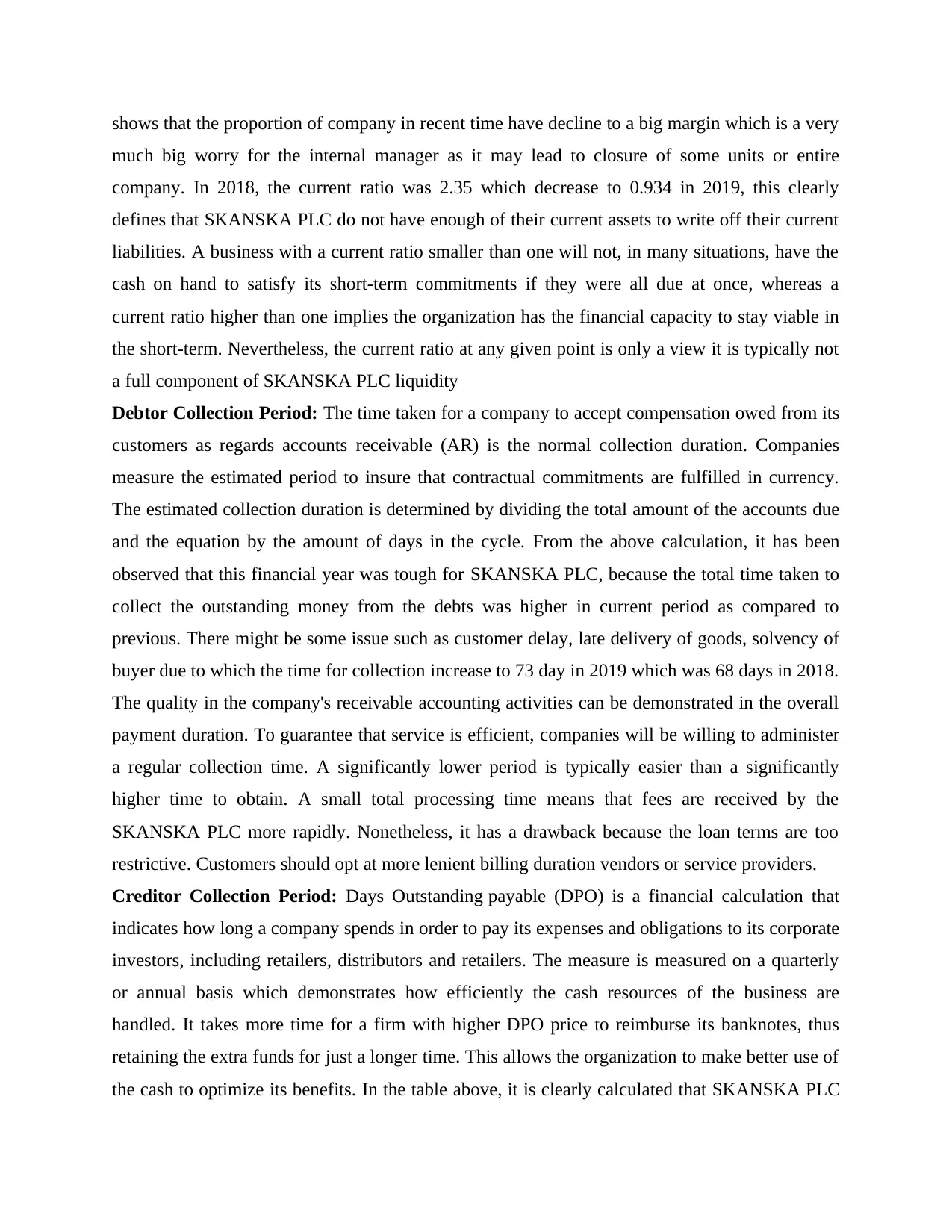
shows that the proportion of company in recent time have decline to a big margin which is a very
much big worry for the internal manager as it may lead to closure of some units or entire
company. In 2018, the current ratio was 2.35 which decrease to 0.934 in 2019, this clearly
defines that SKANSKA PLC do not have enough of their current assets to write off their current
liabilities. A business with a current ratio smaller than one will not, in many situations, have the
cash on hand to satisfy its short-term commitments if they were all due at once, whereas a
current ratio higher than one implies the organization has the financial capacity to stay viable in
the short-term. Nevertheless, the current ratio at any given point is only a view it is typically not
a full component of SKANSKA PLC liquidity
Debtor Collection Period: The time taken for a company to accept compensation owed from its
customers as regards accounts receivable (AR) is the normal collection duration. Companies
measure the estimated period to insure that contractual commitments are fulfilled in currency.
The estimated collection duration is determined by dividing the total amount of the accounts due
and the equation by the amount of days in the cycle. From the above calculation, it has been
observed that this financial year was tough for SKANSKA PLC, because the total time taken to
collect the outstanding money from the debts was higher in current period as compared to
previous. There might be some issue such as customer delay, late delivery of goods, solvency of
buyer due to which the time for collection increase to 73 day in 2019 which was 68 days in 2018.
The quality in the company's receivable accounting activities can be demonstrated in the overall
payment duration. To guarantee that service is efficient, companies will be willing to administer
a regular collection time. A significantly lower period is typically easier than a significantly
higher time to obtain. A small total processing time means that fees are received by the
SKANSKA PLC more rapidly. Nonetheless, it has a drawback because the loan terms are too
restrictive. Customers should opt at more lenient billing duration vendors or service providers.
Creditor Collection Period: Days Outstanding payable (DPO) is a financial calculation that
indicates how long a company spends in order to pay its expenses and obligations to its corporate
investors, including retailers, distributors and retailers. The measure is measured on a quarterly
or annual basis which demonstrates how efficiently the cash resources of the business are
handled. It takes more time for a firm with higher DPO price to reimburse its banknotes, thus
retaining the extra funds for just a longer time. This allows the organization to make better use of
the cash to optimize its benefits. In the table above, it is clearly calculated that SKANSKA PLC
much big worry for the internal manager as it may lead to closure of some units or entire
company. In 2018, the current ratio was 2.35 which decrease to 0.934 in 2019, this clearly
defines that SKANSKA PLC do not have enough of their current assets to write off their current
liabilities. A business with a current ratio smaller than one will not, in many situations, have the
cash on hand to satisfy its short-term commitments if they were all due at once, whereas a
current ratio higher than one implies the organization has the financial capacity to stay viable in
the short-term. Nevertheless, the current ratio at any given point is only a view it is typically not
a full component of SKANSKA PLC liquidity
Debtor Collection Period: The time taken for a company to accept compensation owed from its
customers as regards accounts receivable (AR) is the normal collection duration. Companies
measure the estimated period to insure that contractual commitments are fulfilled in currency.
The estimated collection duration is determined by dividing the total amount of the accounts due
and the equation by the amount of days in the cycle. From the above calculation, it has been
observed that this financial year was tough for SKANSKA PLC, because the total time taken to
collect the outstanding money from the debts was higher in current period as compared to
previous. There might be some issue such as customer delay, late delivery of goods, solvency of
buyer due to which the time for collection increase to 73 day in 2019 which was 68 days in 2018.
The quality in the company's receivable accounting activities can be demonstrated in the overall
payment duration. To guarantee that service is efficient, companies will be willing to administer
a regular collection time. A significantly lower period is typically easier than a significantly
higher time to obtain. A small total processing time means that fees are received by the
SKANSKA PLC more rapidly. Nonetheless, it has a drawback because the loan terms are too
restrictive. Customers should opt at more lenient billing duration vendors or service providers.
Creditor Collection Period: Days Outstanding payable (DPO) is a financial calculation that
indicates how long a company spends in order to pay its expenses and obligations to its corporate
investors, including retailers, distributors and retailers. The measure is measured on a quarterly
or annual basis which demonstrates how efficiently the cash resources of the business are
handled. It takes more time for a firm with higher DPO price to reimburse its banknotes, thus
retaining the extra funds for just a longer time. This allows the organization to make better use of
the cash to optimize its benefits. In the table above, it is clearly calculated that SKANSKA PLC
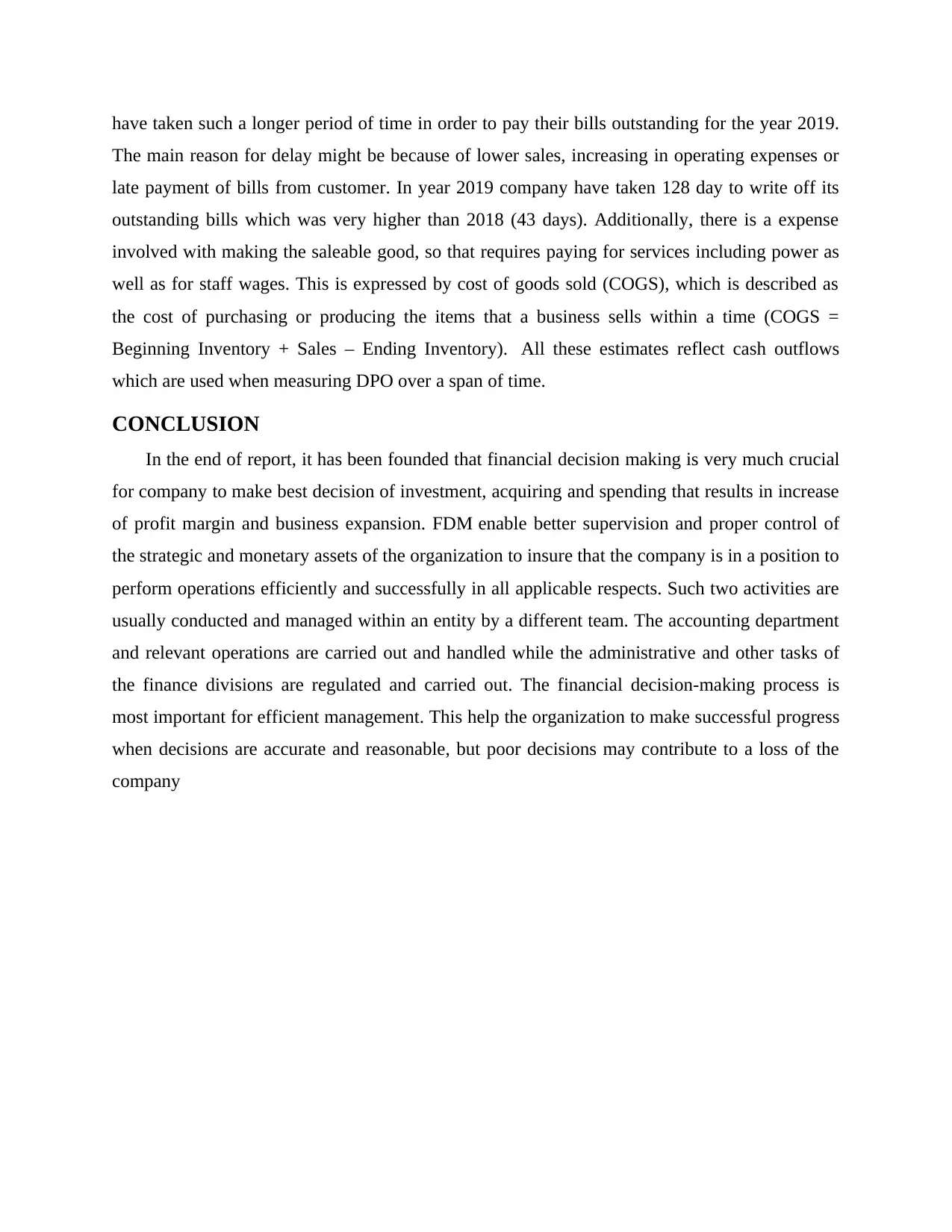
have taken such a longer period of time in order to pay their bills outstanding for the year 2019.
The main reason for delay might be because of lower sales, increasing in operating expenses or
late payment of bills from customer. In year 2019 company have taken 128 day to write off its
outstanding bills which was very higher than 2018 (43 days). Additionally, there is a expense
involved with making the saleable good, so that requires paying for services including power as
well as for staff wages. This is expressed by cost of goods sold (COGS), which is described as
the cost of purchasing or producing the items that a business sells within a time (COGS =
Beginning Inventory + Sales – Ending Inventory). All these estimates reflect cash outflows
which are used when measuring DPO over a span of time.
CONCLUSION
In the end of report, it has been founded that financial decision making is very much crucial
for company to make best decision of investment, acquiring and spending that results in increase
of profit margin and business expansion. FDM enable better supervision and proper control of
the strategic and monetary assets of the organization to insure that the company is in a position to
perform operations efficiently and successfully in all applicable respects. Such two activities are
usually conducted and managed within an entity by a different team. The accounting department
and relevant operations are carried out and handled while the administrative and other tasks of
the finance divisions are regulated and carried out. The financial decision-making process is
most important for efficient management. This help the organization to make successful progress
when decisions are accurate and reasonable, but poor decisions may contribute to a loss of the
company
The main reason for delay might be because of lower sales, increasing in operating expenses or
late payment of bills from customer. In year 2019 company have taken 128 day to write off its
outstanding bills which was very higher than 2018 (43 days). Additionally, there is a expense
involved with making the saleable good, so that requires paying for services including power as
well as for staff wages. This is expressed by cost of goods sold (COGS), which is described as
the cost of purchasing or producing the items that a business sells within a time (COGS =
Beginning Inventory + Sales – Ending Inventory). All these estimates reflect cash outflows
which are used when measuring DPO over a span of time.
CONCLUSION
In the end of report, it has been founded that financial decision making is very much crucial
for company to make best decision of investment, acquiring and spending that results in increase
of profit margin and business expansion. FDM enable better supervision and proper control of
the strategic and monetary assets of the organization to insure that the company is in a position to
perform operations efficiently and successfully in all applicable respects. Such two activities are
usually conducted and managed within an entity by a different team. The accounting department
and relevant operations are carried out and handled while the administrative and other tasks of
the finance divisions are regulated and carried out. The financial decision-making process is
most important for efficient management. This help the organization to make successful progress
when decisions are accurate and reasonable, but poor decisions may contribute to a loss of the
company
Secure Best Marks with AI Grader
Need help grading? Try our AI Grader for instant feedback on your assignments.
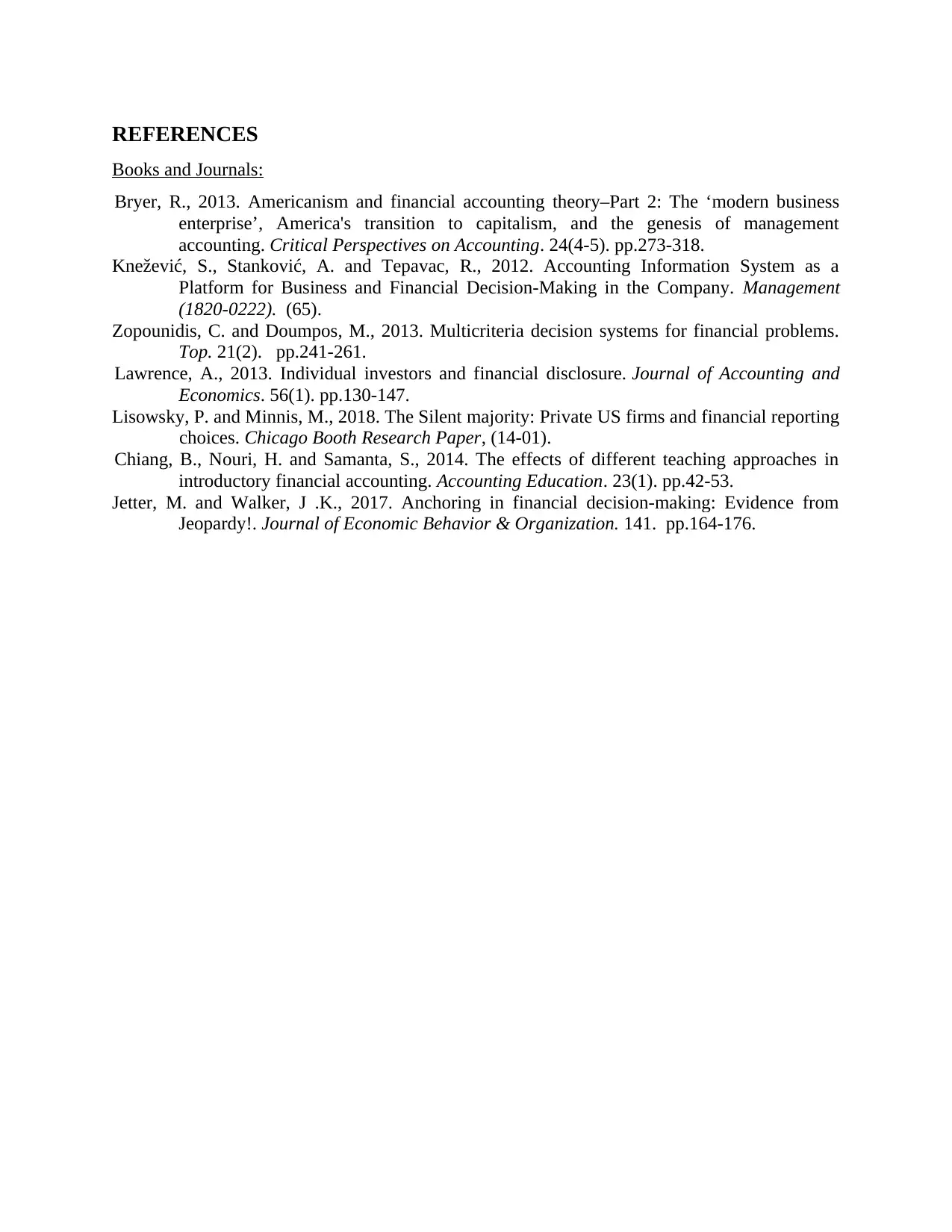
REFERENCES
Books and Journals:
Bryer, R., 2013. Americanism and financial accounting theory–Part 2: The ‘modern business
enterprise’, America's transition to capitalism, and the genesis of management
accounting. Critical Perspectives on Accounting. 24(4-5). pp.273-318.
Knežević, S., Stanković, A. and Tepavac, R., 2012. Accounting Information System as a
Platform for Business and Financial Decision-Making in the Company. Management
(1820-0222). (65).
Zopounidis, C. and Doumpos, M., 2013. Multicriteria decision systems for financial problems.
Top. 21(2). pp.241-261.
Lawrence, A., 2013. Individual investors and financial disclosure. Journal of Accounting and
Economics. 56(1). pp.130-147.
Lisowsky, P. and Minnis, M., 2018. The Silent majority: Private US firms and financial reporting
choices. Chicago Booth Research Paper, (14-01).
Chiang, B., Nouri, H. and Samanta, S., 2014. The effects of different teaching approaches in
introductory financial accounting. Accounting Education. 23(1). pp.42-53.
Jetter, M. and Walker, J .K., 2017. Anchoring in financial decision-making: Evidence from
Jeopardy!. Journal of Economic Behavior & Organization. 141. pp.164-176.
Books and Journals:
Bryer, R., 2013. Americanism and financial accounting theory–Part 2: The ‘modern business
enterprise’, America's transition to capitalism, and the genesis of management
accounting. Critical Perspectives on Accounting. 24(4-5). pp.273-318.
Knežević, S., Stanković, A. and Tepavac, R., 2012. Accounting Information System as a
Platform for Business and Financial Decision-Making in the Company. Management
(1820-0222). (65).
Zopounidis, C. and Doumpos, M., 2013. Multicriteria decision systems for financial problems.
Top. 21(2). pp.241-261.
Lawrence, A., 2013. Individual investors and financial disclosure. Journal of Accounting and
Economics. 56(1). pp.130-147.
Lisowsky, P. and Minnis, M., 2018. The Silent majority: Private US firms and financial reporting
choices. Chicago Booth Research Paper, (14-01).
Chiang, B., Nouri, H. and Samanta, S., 2014. The effects of different teaching approaches in
introductory financial accounting. Accounting Education. 23(1). pp.42-53.
Jetter, M. and Walker, J .K., 2017. Anchoring in financial decision-making: Evidence from
Jeopardy!. Journal of Economic Behavior & Organization. 141. pp.164-176.
1 out of 11
Related Documents
Your All-in-One AI-Powered Toolkit for Academic Success.
+13062052269
info@desklib.com
Available 24*7 on WhatsApp / Email
![[object Object]](/_next/static/media/star-bottom.7253800d.svg)
Unlock your academic potential
© 2024 | Zucol Services PVT LTD | All rights reserved.




